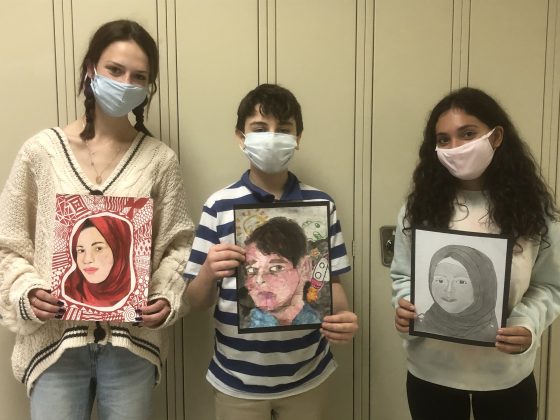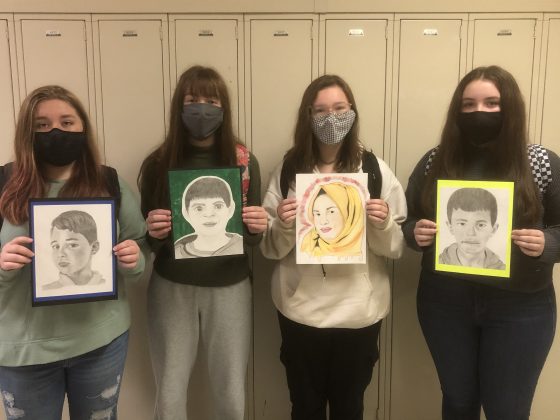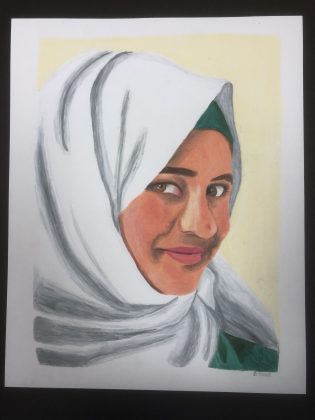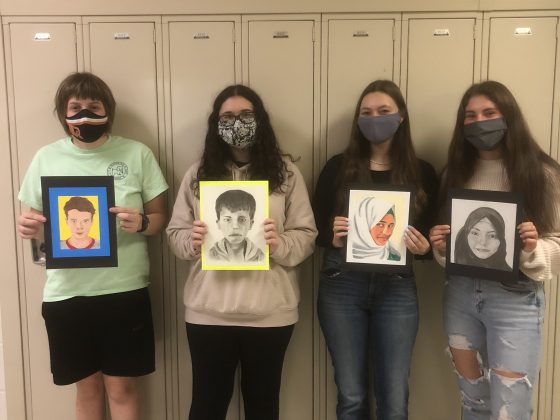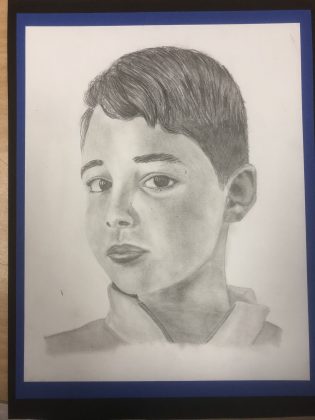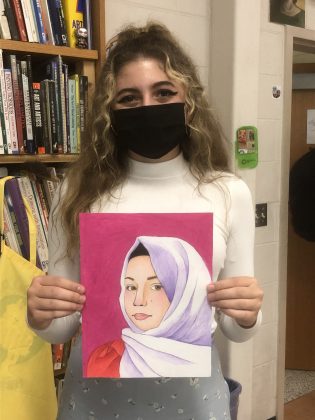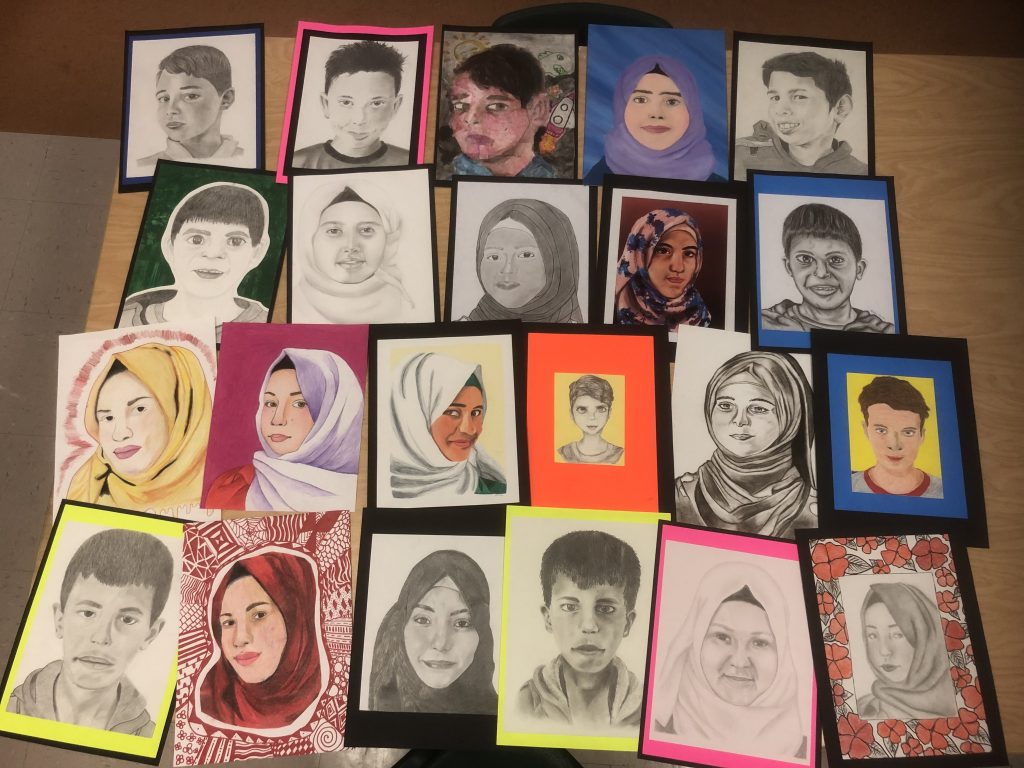

The global pandemic is keeping Clearview Regional High School students relatively homebound.
Their artwork, however, is traversing the globe.
Fifteen members of the school’s National Art Honor Society recently took part in The Memory Project, creating portraits to be gifted to children living in a refugee camp in Syria. The nonprofit was founded in 2004 and aims to connect children and teenagers around the world through art.
“It’s a really cool organization,” Dennis Weaver said. “They try to get American art students to do these portraits, to let (the children) know someone else is thinking about them. It gives them a little memento of their youth, and it brightens their day.”
Weaver is co-advisor of Clearview’s National Art Honor Society with Joe Marano. The school’s chapter has been around for about 15 years, while Weaver has been teaching art at Clearview for 31 years.
Part of the honor society’s mission is to bring the students’ artwork outside of the school.
Weaver’s former coworker came across The Memory Project online, and after looking into it, they realized it perfectly aligned with the club’s goals.
That was three years – and many, many portraits – ago. The Memory Project founder Ben Shumaker said the involvement and talent from schools such as Clearview is what keeps the nonprofit going, particularly during this challenging time of COVID-19.
“I really am grateful. The biggest feeling I have day after day, year after year, is gratitude for the teachers and students who do this,” Shumaker said.
The Memory Project found its beginnings 17 years ago, although it didn’t officially start until a year later.
After graduating from college in 2003, Shumaker packed his bags – and his camera – and set out to volunteer. He ended up spending time at an orphanage in Guatemala, where he was helping the children in day-to-day activities.
“I was just focused in on these core volunteer duties,” Shumaker said.
One day when taking photos of the kids, an adult at the orphanage mentioned to Shumaker that he didn’t have a single image of himself as a child. He suggested the young photographer send the pictures to the kids as keepsakes.
“That really struck me deeply. I hadn’t been tuned into that at all,” Shumaker explained. “It just sort of stuck in my mind for months.”
After sending those photos back to the orphanage, it was about nine months later that these thoughts germinating in Shumaker’s mind started to turn into something more.
“I just happened to be reflecting on portraiture and how I enjoyed doing portraits in high school art class,” he said. “There are so many talented art students across our country. It was really this untapped resource.”
Shumaker wondered what could happen if high school artists were given photos of these children from orphanages around the world.
Then he stopped wondering and set out to get an answer.
The Memory Project was born, and since 2004, it has grown beyond only orphanages to include children in a variety of trying circumstances.
“We make portraits for kids in so many different situations, but the one thing the kids all have in common is they’ve experienced really difficult life challenges in one way or another,” Shumaker said. “We hope the portrait will be a special memory that will honor their unique person, their special spirit, and kind of serve as a keepsake for them later in life.”
In the three years Clearview has taken part in The Memory Project, the club has done as many as 30 portraits, and as few as 10. This year there were 15 portraits, and each was created by two different students, so 30 were sent all together.
Orchestrating the project was no simple task during the pandemic, when students were learning either remotely or under a hybrid model, and clubs were not permitted to meet until very recently.
Regardless, Weaver was pleasantly surprised with the results.
“This particular group did very well,” he said.
Shumaker concurred.
“They were beautiful. They’ve always done great work,” Shumaker said. “They’ve done it for three years now. That’s really what keeps it going strong – the teachers that do it every year and do it well. They really put thought into it. If it weren’t for schools like that and teachers like Dennis, the whole thing would have fizzled a long time ago.”
Sophomore Mia Lupo created a vibrant portrait of a young girl using colored pencils. This was the first time she took part in the project, and she’s looking forward to doing it again.
“Realism isn’t usually my strong suit, so I’m definitely really proud of it,” Lupo said. “(The Memory Project) has us attach a picture of ourselves on the back of our portraits so the kids can see their artists. Even though I’m never going to meet this girl probably, we still have this connection from thousands of miles away.
“We live in a world where that’s possible, and I think that’s really cool.”
For Gabriella Pavard, the chance to help others was what prompted her to participate. The junior also used color pencils for her portrait.
“This is a new way to connect with people that you don’t even know. It’s a really nice idea. These kids have lost so much, and this just gives them something to make their day,” Pavard said. “Every time they see it, they’re going to think of me, through their whole life.”
The pandemic has been a challenge for The Memory Project, with so many schools closed to in-person learning around the country. Clearview, however, will continue doing its part; Weaver plans to ask for another batch for his students this school year.
“It’s good for everybody. It’s good for the children receiving the portraits. It’s good for our students to take their skills outside of the building a little bit,” Weaver said. “I think it’s just cool for people in our community to see us reaching out to people in other parts of the world.
“It’s a way for students to realize they actually do have things pretty good in a lot of ways compared to some people,” Weaver added. “Things we take for granted, something like safety and having a place to say, these kids don’t have that.”
Shumaker is proud The Memory Project is still going strong after 16 years.
“It’s been great,” he said. “I love that the project hasn’t lost any of its special meaning to me over the years.”
The Memory Project is always looking for more participants. In addition to the high school program for advanced artists, the nonprofit has started a global art exchange for any students in grades kindergarten through 12th. To learn how to get a school involved, visit www.memoryproject.org.



